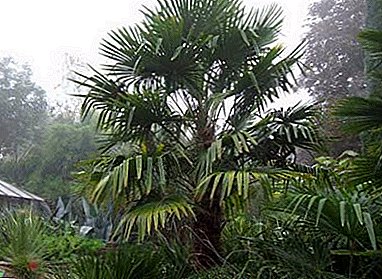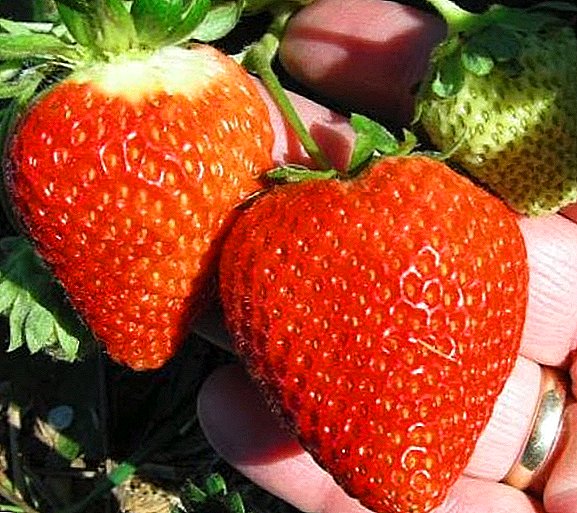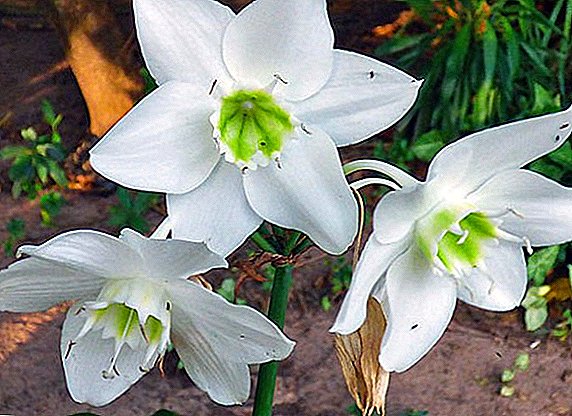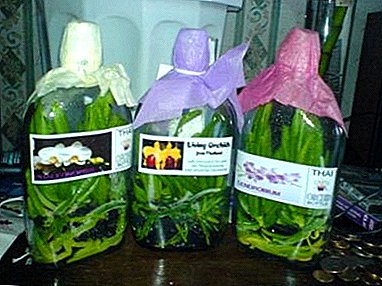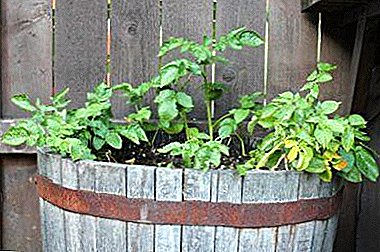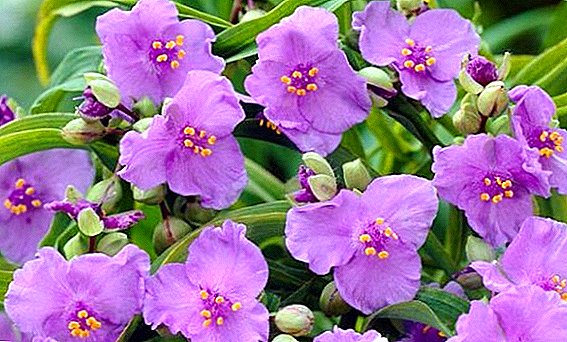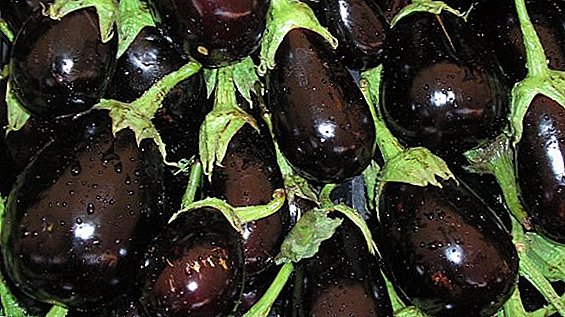 Eggplant - one of the most popular vegetables, which is famous for its spicy taste. There are many options for dishes with them, but not all of them are ready to conquer you with their taste. Experienced owners of suburban areas are trying to choose tender and juicy varieties of eggplants, which do not have a characteristic bitterness. One of those is the variety "Black handsome", characteristics and description of which speak of the simplicity of cultivation and the wonderful taste of the fruit.
Eggplant - one of the most popular vegetables, which is famous for its spicy taste. There are many options for dishes with them, but not all of them are ready to conquer you with their taste. Experienced owners of suburban areas are trying to choose tender and juicy varieties of eggplants, which do not have a characteristic bitterness. One of those is the variety "Black handsome", characteristics and description of which speak of the simplicity of cultivation and the wonderful taste of the fruit.
Description and photo
This variety of eggplants was bred in the last century and has since gained popularity with many gardeners. 
Check out the most popular varieties of eggplants: Prado, Diamond, Valentina F1 and Clorinda F1.
Bushes
Shrubs usually reach a height of 70 cm and have a moderate spreading. Stems pubescent, with slightly toothed leaves of green color and thorns.
Did you know? In eastern countries, eggplant is considered a vegetable that gives longevity.
Fruit
Variety "Black Beauty" has earned a lot of positive feedback for a good fruit ovary. The average weight of one fruit is 300-400 g but some instances may have weight 0.9-1 kg. Medium size eggplant, 15-20 cm long 
Characteristics of a variety
Ripe eggplants of this variety have the following characteristics:
- the shape of vegetables is pear-shaped, oblong;
- the name of the species speaks eloquently of the color of the fruit, among which there are shades - from dark purple to purple-black;
- thin and glossy peel;
- tender yellowish flesh with a small amount of seeds;
- rich taste without bitterness.

Important! Eggplant fruits are not recommended to bring to full ripeness and ripening, because then they begin to taste bitter.
Advantages and disadvantages
Choosing a good variety of eggplants for planting on your own site, I want to know about all its positive and negative sides.
The main advantages of the "Black Beauty":
- ease of growing;
- resilience, since this type of disease is much less common than other varieties;
- high yield (up to 9 kg per 1 sq. m);
- opportunity to increase the crop, if planted seedling way.
 Despite such colorful benefits of the variety, He has some drawbacks:
Despite such colorful benefits of the variety, He has some drawbacks:- the variety is suitable for growing only in warm regions due to low cold resistance (in cold regions it is recommended to grow in greenhouses);
- fastidiousness in the care (only high-quality soil, fertilizers, watering, etc.).

Important! The optimum temperature for plant growth - 24-27 ° C. At a temperature of 15 ° C and below the bushes stop growing and die. At a temperature of 30 ° C and higher the outcome will be the same.
Grow seedlings
Rassadnaya technology of growing vegetables makes it possible to get an early harvest. We learn how to grow seedlings and provide follow-up care for her.
Timing
The optimal time for growing eggplant seedlings "Black Beauty" - February March. It is recommended to plant the plants in the soil in the first half of May. 
Seed preparation and selection
Since this variety different demanding care, to get a good harvest will have to make some effort. And you need to start with the choice of high-quality seed material. Experts unanimously recommend choosing the seeds of the first selection labeled F1. The seedlings of the first selection have an increased resistance to fluctuations in the temperature regime of the habitat.
Additionally, you can independently sort and remove small seeds because they do not give strong bushes. After that, you can conduct another test for the density and weight of the seeds: shake the seed in saline solution and discard those seeds that float up; dry the rest and prepare for disembarkation.  Using the seedling method involves the purchase of black soil, which will relieve from the difficulties with the preparation of the soil. When using garden soil, you will need to disinfect it from fungus and infections, to make fertilizer. Acquired seed material is also advised to be processed in a growth stimulator, which only enhances the growth and viability of plants.
Using the seedling method involves the purchase of black soil, which will relieve from the difficulties with the preparation of the soil. When using garden soil, you will need to disinfect it from fungus and infections, to make fertilizer. Acquired seed material is also advised to be processed in a growth stimulator, which only enhances the growth and viability of plants.
Did you know? In ancient times, eggplant was considered a poisonous vegetable. From the peel of the ripe fruit produced a "poisonous" powder, which is mixed into the food of his enemies.
Sowing scheme
After sowing seeds in the soil must be used additional lighting. Since the landing is made in February, the duration of daylight hours is no more than 9 hours, and for germination of seedlings, a 12-hour stay under the sun is necessary. To do this, provide illumination Fitolamp or incandescent lamps. After 4-5 weeks, when shoots appear, it is possible to make a pick. Plants are transplanted into individual containers in order to accelerate the development of the root system of future bushes. 
Seedling care
Care for young seedlings is quite simple. It is necessary to regularly spray the seedlings from the spray gun, loosen the soil and feed. Observance of all conditions is mandatory for obtaining healthy and strong seedlings, which will be the key to obtaining a good harvest. Young seedlings are planted in open soil or a greenhouse on the 80th day after germination (but for this, the air temperature must exceed 15 ° C). During this period, 6-8 full leaflets should be formed on the seedling.
Important! Eggplant fruits contain a lot of nicotinic acid (vitamin PP), so these vegetables are recommended to add to the diet for anyone who wants to get rid of nicotine addiction.

Watering, feeding, formation
Eggplant go fast on the beds, if you provide them with the necessary care. Plants planted in the soil do not like both drought and excess moisture. The first 10 days after planting produce a minimum watering of seedlings daily, after - once every two days. The most convenient time for irrigation is evening, and the optimum water temperature for irrigation is 25 ° C. From lack of moisture, the ovary, the flowers and the bushes themselves wither, and the fruits become deformed and become bitter. Excessive watering provokes diseases of plants and fruits.
Feeding eggplants - an integral part of the care, which is recommended to carry out at least five times per season. At the end of the third week after planting, the fertilizer is prepared according to the recipe: in 10 l of water, dissolve 10 g of nitrogen, potash and phosphate fertilizers. If the ovaries are formed faster, the amount of fertilizer is doubled (not 10 g each, but 20 g per bucket of water). During subsequent feedings the same proportions of fertilizer are maintained. Top dressing is made again before the appearance of the fruit and then every two weeks. Under these conditions, the formation of healthy and strong plants occurs rapidly. To accelerate growth, it is advised to pinch the top of the bush. 
Did you know? In folk medicine, eggplants have proven to be a remedy for toothache and bleeding gums.
Pests and diseases
During the cultivation of eggplant collision with plant diseases is almost inevitable. The main diseases of this culture:
- late blight;
- fungus;
- gray rot
 The main pests of eggplants: the Colorado potato beetle, aphid, slugs, etc. The variety "Black Handsome" is considered to be viable and little prone to disease, but also he needs precautions such as:
The main pests of eggplants: the Colorado potato beetle, aphid, slugs, etc. The variety "Black Handsome" is considered to be viable and little prone to disease, but also he needs precautions such as:- dusting the ground near the bushes with ashes;
- spraying of tar from the Colorado potato beetle;
- the layout of the green branches of alder every 50 cm to protect against the bear;
- pollinating the plant with dry mustard and loosening the soil - against slugs and rot.
If you want to grow healthy eggplants, learn more about their pests, prevention and measures against insects.Also do not forget about the regular cutting of the lower leaves.

Important! Experienced gardeners are disinfecting seeds with potassium permanganate on the eve of sowing to ensure resistance to diseases.
Harvesting and storage
Eggplant pear-shaped fruits appear approximately 3 months after germination. You can shoot them when the mass of one reaches 200-250 g. It is this period when the size of the fruit corresponds to the parameters of the variety, is considered the most favorable for harvesting. The frequency of collection - once a week. It is best to cut the fruit with a sheath or knife, leaving a part of the stem 4-5 cm long. 
To preserve the freshness and taste of eggplants, the harvested crop should be wiped with a dry towel (it should never be washed) and placed in a dark room with a temperature of 0-2 ° C. After a few weeks, check the condition of the fruit, leaving only the vegetables with dense pulp. Next - wrap them in paper, put on a straw cover 20 cm high and cover with a thick cloth. So you can extend the life of eggplants for up to 3 months.
With the satisfaction of all needs and the proper care of demanding varieties of eggplants, the plant will give you tasty and juicy fruits. We wish you success!


